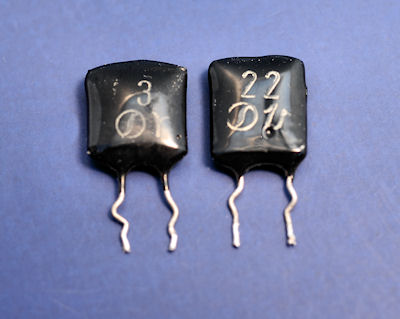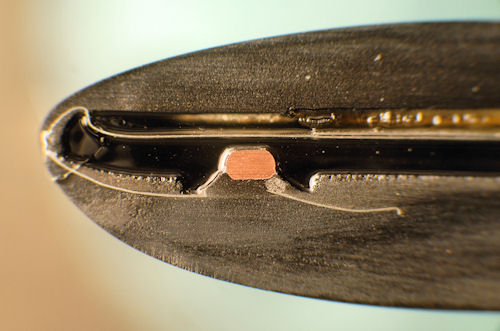
Replace the small low value black rectangular capacitors (3, 6, 9, 22 & 33 pF) in your Sansui AU-919 integrated amplifier, or it will almost certainly fail, destroying the unobtainable Sanken high speed output transistors. If the caps have not been replaced, you should stop using the amplifier and not turn it on again until they have been replaced. That is really all you need to know. The curious may also find the rest of the info on this page interesting.
EchoWars (Glenn) of Audiokarma fame was the first to determine the cause of failing Kenwood amplifiers that used these capacitors, and coined the name. It was quickly realized that the same parts were used in various Sansui amplifiers, resulting in quite a few blown output stages. Dozens, if not hundreds, of posts on the forums discuss this and related reliability and service issues, with EchoWars well thought out solutions. This page is an attempt to pull together the Black Flag information and add some quantitative measurements. It stands on the shoulders of EchoWars, who originally drained the swamp and removed the alligators!

Well, they look like a small black flag, thin, rectangular and waving in the breeze. Echowars paraphrased the old Black Flag insecticide catch phrase into "Kills Amps Dead!"
As far as I know, there are 26. There are 12 on the control board and 14 on the power amp board. The exact locations may depend on the revision of the boards. On the one hand, they look like nothing else on the boards and are easy to see if you're looking right at them. On the other hand, I missed a few on the first round of replacement because they tend to hide behind other parts.
These are very small value capacitors and have no effect at audio frequencies. Their purpose is to stabilize the amplifier circuit so it doesn't go into high frequency oscillation. Because they have no effect at audio frequencies, it's a bit of a mystery why Sansui chose these unusual polystyrene caps. Ceramic or silver-mica is more common and works just fine, with known reliability.
From an external measurement viewpoint, the value goes down and the losses go up. The caps also become noisy and unstable. When you design a high speed circuit where 3 pF is the difference between stability and destruction, having the value go down, plus injecting noise, could be just the oscillation trigger you don't want.
An internal look might be enlightening, so let's get out the saw.

This is a view of a 22 pF capacitor that's been sectioned across the middle. You can see that the leads are attached to two pieces of thin metal foil. They loop back around just outside our view, as shown in the next image, but the actual capacitance is obtained from the thin gap between the two pieces in the central area.

The dielectric is listed as polystyrene in the AU-919 parts list, and this is confirmed by the fact that the dielectric easily dissolves in solvent, something other films wouldn't do.
Other than shorting out, there's almost nothing that can go wrong with the actual foil and dielectric area that creates the capacitance. The problem is most likely the attachment of the leads to the foil, in fact the lead area shown above looks a bit suspect in the way the foil is displaced. Any sort of oxidation, corrosion or disconnection that increases the resistance of the contact between the lead and the foil will degrade the capacitor and cause the observed symptoms. Since connection problems only worsen with time, and the exact conditions that result in damaging instability are uncertain, it's impossible to predict if or when a given amplifier will fail. This is probably not a case where a long period of trouble-free operation predicts the future.
As you'll see, statistics are not working in our favor; fully half of the 3 pF caps are bad.
| Location | Marked | Measured C | DF | Error | Comments |
| power | 33 | 30.311 | 0.00057 | -8.15% | |
| power | 33 | 33.192 | 0.00065 | 0.58% | |
| power | 33 | 31.757 | 0.00056 | -3.77% | |
| power | 33 | 33.085 | 0.00051 | 0.26% | |
| power | 22 | 20.321 | 0.00087 | -7.63% | |
| power | 22 | 20.403 | 0.00076 | -7.26% | |
| power | 3 | 3.185 | 0.0023 | 6.17% | |
| power | 3 | 1.549 | 0.095 | -48.37% | bad |
| power | 3 | 2.809 | 0.001 | -6.37% | |
| power | 3 | 3.099 | 0.002 | 3.30% | |
| power | 3 | 3.099 | 0.0027 | 3.30% | |
| power | 3 | 1.499 | 0.07 | -50.03% | bad |
| power | 3 | 0.669 | 0.02 | -77.70% | bad |
| power | 3 | 1.139 | 0.07 | -62.03% | bad |
| control | 22 | 19.999 | 0.00062 | -9.10% | |
| control | 22 | 20.519 | 0.00074 | -6.73% | |
| control | 22 | 21.819 | 0.00056 | -0.82% | |
| control | 22 | 19.969 | 0.00056 | -9.23% | |
| control | 22 | 21.999 | 0.00068 | 0.00% | |
| control | 22 | 21.049 | 0.00063 | -4.32% | |
| control | 6 | 6.589 | 0.0022 | 9.82% | |
| control | 6 | 6.799 | 0.0023 | 13.32% | |
| control | 6 | 6.129 | 0.0024 | 2.15% | |
| control | 6 | 7.009 | 0.0054 | 16.82% | bad |
| control | 9 | 9.349 | 0.00126 | 3.88% | |
| control | 9 | 9.469 | 0.00152 | 5.21% |
The key parameter is dissipation factor. If it's substantially higher than other parts, it's a good indication that the lead contact is deteriorating. Naturally a large decrease in value is another sign and anything worse than -10% is suspect.
The usual replacement is a dipped silver-mica, typically rated at 500V. A 500V part isn't needed, but that's the most common low value silver-mica. While these are perfectly fine, they're becoming more and more expensive. There is no problem using NP0/C0G disc ceramic capacitors, which are actually superior to silver-mica with regards to all parameters. These parts do not affect the audio signal at all, and even a lower quality ceramic would probably be fine. Bowing to audiophile sensibilities, I'd still stick with the tried and true silver-mica or the excellent NP0/C0G parts.
The power board is very easy as it comes out the bottom just by removing 4 screws. If the unit is on one side, some wood blocks or a medium sized lab jack are recommended to support the power board and heat sink and avoid stress on the wires.
The control board is also not too difficult. It comes out the top, but you have to be careful of the two solid core ribbon wires. If you flex them they will break, so unsolder them both from the control board. There's enough slack in the other wires that the board can be folded out to access the back. You'll have to remove the volume control shaft, best done by removing the small inner snap ring and pulling the shaft out a few inches. If you find it's still in the way, remove the knob (metric hex key) and take it out entirely.
Most of the other boards are not nearly so easy, so one best hope nothing goes wrong with them. Try to refrain from pointless mods and audiophile "upgrades". Sansui probably knew more about what they were doing then you do, at least circuit-wise, and changing things in a circuit this fast and sensitive is asking for trouble. If you have to replace parts, choose parts that are not only electrical equivalents, but physically the same as well. Not all is perfect however, and some of the packaged full wave rectifiers tend to generate a lot of RF noise and could probably benefit from replacement or snubbers.
Sansui is well known for securing larger capacitors with a brown glue that becomes corrosive over time. This can do a lot of damage to component leads, so it's best removed wherever found. A small flat blade scraper (square ended X-Acto knife) works well.
Mechanically they missed the mark a few times. The rear panel input jacks were a poor design, with only a couple plastic ears holding them to the panel. Too much force, or heavy "audiophool" cables will almost certainly result in their destruction. They can be repaired with Loctite Plastic Bonder and then redrilled for the self-tapping screws. Several locations should have used connectors to allow for service. Many sheet metal screws are used in places where machine screws and even PEM nuts would have been a better choice on an amplifier at this weight and quality level. Finally, the spring loaded speaker wire terminals fall into the category of "what were they thinking?"
No question it has its quirks, but from a technical/design standpoint, the amplifier is quite a tour de force.
Sansui models that have black flag capacitors include the AU-X1, BA-F1, AU-519 and AU-719. There may be other models as well, and other manufacturers (Kenwood) have used these same parts.
C. Hoffman
last edit June 8, 2014